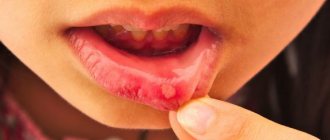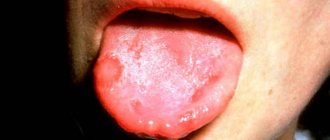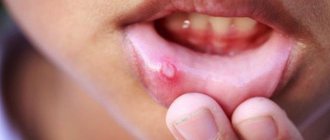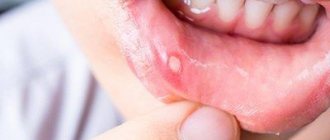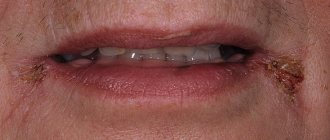Symptoms
The main symptoms of aphthous stomatitis can be detected with the naked eye by looking into the oral cavity.
- Most often, ulcers are located on the inside of the lower lip, but they may be present on the cheeks and gums. Their size can be very small, or cover the entire mucous membrane.
- The resulting ulcers cause pain and discomfort to the child, and bad breath appears. This affects his behavior. Increased irritability occurs, sleep patterns are disrupted, and there is no appetite.
- A white coating may form on the tongue, accompanied by small blisters. They bring a burning sensation. In this regard, children often refuse to eat.
- Body temperature rises. And along with it, the lymph nodes in the neck can become inflamed and enlarged.
The development of aphthous stomatitis in children occurs in several stages. Each has its own characteristics of manifestation. At the initial stage, a cough and runny nose appears, and the throat turns red. Then the body temperature rises and the stage of the appearance of rashes begins. First, single ulcers appear, and then whole groups are formed. They look like yellowish spots with a red border. In its acute form, the disease can even affect the throat.
The disease can occur in both infants and school-age children. Therefore, it is necessary to periodically conduct a diagnostic examination of the oral cavity.
There are several options for the course of the disease:
- Acute is a rapidly progressive form that reaches a peak within a few days. Often accompanied by viral diseases.
- Chronic – occurs in the absence of treatment of the acute form. Accompanied by general malaise. It may disappear on its own, but soon appears again.
- Recurrent - may appear after treatment of a chronic form. Sharply worsens after a long time.
Stomatitis
Cold
HIV
Fungus
Scarlet fever
Gastritis
12410 24 September
IMPORTANT!
The information in this section cannot be used for self-diagnosis and self-treatment.
In case of pain or other exacerbation of the disease, diagnostic tests should be prescribed only by the attending physician. To make a diagnosis and properly prescribe treatment, you should contact your doctor. Stomatitis: causes, symptoms, diagnosis and treatment methods.
Definition
Stomatitis is a collective name for diseases of the oral mucosa, manifested by its redness, swelling with the formation of areas of erosion, ulcers or blistering rashes. Stomatitis affects approximately 20% of the population, most often children. Stomatitis can be either an independent disease or a complication or manifestation of other diseases (for example, scarlet fever, influenza, measles, etc.).
Causes of stomatitis
There is no single factor that is the sole cause of oral inflammation. With stomatitis, bacteria or viruses are detected, especially in ulcers on the mucous membrane. However, a diverse microflora is always present in the oral cavity, but stomatitis makes itself felt only when there is a strong additional impact on this microflora.
These impacts include:
- trauma to the mucous membrane caused by overzealous brushing of teeth, rough food, etc.;
- decreased immunity due to colds, vitamin deficiencies, chronic diseases, stress, poor nutrition, as well as more serious diseases (anemia, cancer and autoimmune diseases, HIV);
- entry of a large number of pathogenic microorganisms into the oral cavity through dirty hands, unwashed foods, etc.;
- conditions for the proliferation of pathogenic microflora due to the presence of caries, tartar and plaque, lack of proper teeth cleaning, etc.;
- uncontrolled use of drugs that affect the quantity and quality of saliva and reduce its antimicrobial potential;
- inhibition of normal microflora by antibiotics;
- dehydration of the body with a decrease in the amount of saliva;
- diseases of the gastrointestinal tract (gastritis, pancreatitis, etc.).
Classification of the disease
Due to its occurrence:
- traumatic stomatitis
occurs as a result of the influence of physical (wound, burn from hot food, etc.) or chemical (burn of the oral mucosa with caustic substances, etc.) factors on the mucous membrane; - infectious stomatitis
occurs as a result of a viral, bacterial or fungal infection; - specific stomatitis
occurs as a result of a specific infection (tuberculosis, syphilis); this group includes radiation, drug, and stomatitis due to occupational diseases; - symptomatic stomatitis
develops against the background of diseases of the gastrointestinal tract, cardiovascular, nervous, endocrine systems, and blood diseases; - allergic stomatitis
develops upon contact with allergens.
According to the clinical picture:
- catarrhal stomatitis;
- ulcerative stomatitis;
- aphthous stomatitis.
With the flow:
- spicy;
- chronic.
There are stomatitis associated with dental problems - for example, denture stomatitis occurs due to damage to the mucous membrane by dental structures, due to poor care of removable dentures, and the patient’s failure to comply with oral hygiene.
Symptoms of stomatitis
In children, the disease is more severe than in adults: body temperature may rise significantly and intoxication may be present.
In adults, oral stomatitis, as a rule, is not accompanied by fever, except in cases of deep damage to the mucous membranes in the ulcerative form of the disease.
The most common is catarrhal stomatitis, which is characterized by inflammation of the oral mucosa without the formation of deep defects (ulcers). For those around you, catarrhal stomatitis manifests itself as “stale breath”, for the patient himself – pain, swelling and redness of the mucous membrane. Gingival papillae are easily injured and bleed.
In persons with pathologies of the gastrointestinal tract, as well as with inadequate treatment, catarrhal stomatitis tends to progress to the next stage - ulcerative with the formation of defects throughout the entire depth of the mucous membrane. It is accompanied by an unpleasant odor from the mouth, even putrefactive, the ulcers are covered with a gray coating, and eating any food leads to increased pain. Ulcerative stomatitis is more severe than catarrhal stomatitis and can cause a slight increase in temperature and enlargement of regional lymph nodes.
Aphthous stomatitis manifests itself in the form of small (3-5 mm) single or multiple defects of the mucous membrane of an oval or round shape, surrounded by a thin bright red border and covered with a yellow-gray fibrin coating. Aphthae do not form simultaneously, so you can see different stages of their development. Healing of aphthae begins after the fibrin plaque peels off on its own and ends with the complete disappearance of the defect.
Allergic stomatitis in the mouth occurs against the background of an exacerbation of the underlying disease - allergies. Increased sensitivity of the body can occur to food, medications, pollen, animal hair, cosmetics and care products, and even clothing. Most often, stomatitis is provoked by toothpastes that contain flavorings and chemical components.
Among viral stomatitis, the most common is herpetic stomatitis, which worsens against the background of ARVI. The disease begins with general malaise and lasts 7-10 days.
The oral mucosa becomes red and swollen, and regional lymph nodes become enlarged. After a few days, a blistering rash appears on the tongue and inner surface of the cheeks, and inside the rash there is a translucent liquid. After the bubbles open, small erosions appear, which are covered with a yellowish film.
Diagnosis of the disease
Adequate treatment of stomatitis can be prescribed by determining what caused it - bacteria, fungi or viruses.
If a fungal infection is suspected and to assess the effectiveness of therapy,
Candida albicans
in an oropharyngeal scraping and culture is performed for yeast-like fungi of the genus
Candida
and
Cryptococcus to determine sensitivity to antifungal drugs.
Causes
The most common reasons:
- Presence of infectious diseases.
- Genetic predisposition.
- Increased sensitivity of the mucous membrane.
- Weak immunity.
- Lack of zinc or iron.
- Lack of vitamins.
- Injuries to the oral mucosa.
- Diseases of the gastrointestinal tract.
- Burn of the mucous membrane.
- Allergy to any food product or hygiene product.
- Caries.
- Dry mouth.
- Using the wrong toothbrush.
- Pulpitis.
- Nervous exhaustion.
- Malocclusion.
What is stomatitis
Viral stomatitis in children is a pathological process characterized by damage to the oral mucosa by a viral infection. In children, the pathology progresses rapidly. This disease is acute or chronic.
The pathogen is transmitted in the following ways:
- airborne;
- through contact with the patient’s blood;
- contact-household.
The main source of infection is a sick person or animal. The baby becomes infected quite easily. Most often this happens in kindergartens and medical institutions.
Treatment
If you detect at least one of the symptoms, you should immediately consult a doctor. Timely detection of the disease allows you to prescribe effective treatment. It is compiled individually, taking into account all the characteristics of the patient. In some cases, tests are required to identify pathogenic microorganisms. Local and general therapy is usually used.
Aphthous stomatitis is not contagious, but in order not to expose the child to additional infections, it is recommended to limit walks in the fresh air during treatment.
Depending on the diagnosis, the following may be prescribed:
- Antipyretics.
- Vitamin course.
- Painkiller.
- Anti-inflammatory.
The initial goal is to eliminate pain and alleviate the condition. For this purpose, antiseptic treatment of the oral cavity is carried out. It prevents the addition of secondary infections. In addition to medications, rinses from decoctions are used:
- Sage.
- Motherwort.
- St. John's wort.
- Daisies.
- Calendula.
- Oak bark.
They cannot replace medical treatment, but these herbs will not hurt as an aid. Before you start rinsing your mouth with herbs, you need to make sure you are not allergic to them.
Treatment of aphthous stomatitis in children is not complete without procedures aimed at strengthening general and local immunity. It is recommended to adhere to proper nutrition and take vitamins. Electrophoresis sessions are possible. Sour fruits, juices, tea, hard, spicy and very salty foods, and carbonated drinks are excluded from the diet. This is necessary in order not to injure areas of inflammation.
If the cause of the disease is dental problems, then dental treatment is prescribed. By treating your teeth, you will be able to quickly get rid of aphthous stomatitis, since the cause of its development will be eliminated.
In infants, aphthous stomatitis is often a reaction to mother's milk. If intolerance is confirmed, the baby must be switched to formula milk.
Treatment of stomatitis using traditional medicine
Medical staff at children's clinics say that when stomatitis is detected, it is best to consult with your doctor. Only a specialist can identify what stage the disease is at and prescribe treatment. However, there are situations when the clinic is not open (for example, evening hours and night time), and the child is very sick and does not feel well. If stomatitis is detected at first, you can resort to traditional medicine. There is no need to think that the disease will go away on its own. If the infection is not eradicated, the child will get even more sick.
In case of stomatitis, the oral cavity should be wiped with a bandage containing a soda solution. Plaque in the mouth is removed with a bandage or a piece of gauze, thereby eliminating the infection. Making a soda solution is very easy: add one teaspoon of soda to one glass of water and mix thoroughly. Before use, the liquid should be stirred so that the soda does not remain at the bottom of the glass. Using soda, you can thoroughly disinfect the oral cavity and mucous membrane, while removing plaque.
You can also try wiping the inside with slimy brilliant green. Procedurally, you need to do the same as with a soda solution. Then soak in brilliant green and thoroughly wipe the child’s mouth.
For older children, you can prepare herbal infusions and give them a mouth rinse after eating. In this case, food particles will be removed, and the mucous membrane will not burst. You can rinse with a chamomile solution, which quickly removes the inflammatory process. It is not uncommon for people to use strong green tea, which is also used as a mouth rinse. This procedure should be carried out several times, and it is not at all necessary to do it after meals.
It is sometimes quite difficult to persuade young children to rinse their mouths, especially if they experience pain there. In this case, they may like rose syrup, which also has a positive effect on eliminating infections in the mouth. You can make this syrup yourself using rose petals, sugar and water. You can easily prepare a decoction of oak bark at home. Herbs you can choose from are burdock, sage, and yarrow. You can prepare a mixture of these herbs and rinse your mouth with the tincture several times a day.
You can also use aloe, which you can simply chew. If a child cannot swallow such a plant, then holding it in his mouth will be enough. Aloe will taste good together with a little honey. However, we must remember that using large amounts of honey for stomatitis can only worsen the disease. When a child is ill, you should use only high-quality products without acid and harsh sensations, which will not cause allergies and irritation of the mucous membrane. It is advisable to limit yourself to a set of dishes that were pleasant to the child and did not cause him discomfort.
Causes of aphthous stomatitis in children
The main causes of this disease are infectious lesions of the oral mucosa or individual allergic reactions that weaken the body’s defenses and provoke the development of the disease. Risk factors may include:
- Infectious diseases (staphylococcal infections, tonsillitis, influenza, diphtheria, adenovirus, etc.).
- Allergic reactions.
- Unbalanced diet with insufficient intake of vitamins C and group B, folic acid, as well as a number of macro- and microelements (zinc, iron, selenium, etc.).
- Anemia and diseases of the digestive system.
- Disturbances in the functioning of the immune system.
- Injuries to the oral mucosa, as well as insufficient oral hygiene in children.
Literature:
- Aphthous stomatitis. Nurse, No. 5, 2015, p. 21.
- Mikhalchenko V.F., Firsova I.V., Fedotova Yu.M. and others. A new approach to the treatment of chronic recurrent aphthous stomatitis (Setton's aphthosis) using the method of photoactivated disinfection and the immunomodulator Galavit. Modern problems of science and education. No. 6, 2015, pp. 1-6.
- Salomão Israel Monteiro Lourenço Queiroz, Marcus Vinícius Amarante da Silva. Ana Miryam Costa de Medeiros. Recurrent aphthous ulceration: an epidemiological study of etiological factors, treatment and differential diagnosis. (Recurrent aphthous ulcers: epidemiological study of etiological factors, treatment and differential diagnosis). An Bras Dermatol. 2018;93(3):341-6.
- Maksimenko P.T., Skripnikova T.P., Khmil T.A. Nomenclature, clinical classification of diseases, changes in the mucous membrane of the oral cavity, lips and tongue. Ukrainian Dental Almanac, 2008, No. 4, pp. 28-36.
- Sunday O. Akintoye, BDS, DDS, MS* and Martin S. Greenberg, DDS, FDSRCS. Recurrent Aphthous Stomatitis. Dent Clin North Am. April 2014; 58(2): 281–297. doi:10.1016/j.cden.2013.12.002
- Galizina O.A. Main aspects of the occurrence, clinical manifestations, treatment and prevention of chronic recurrent aphthous stomatitis. Russian Dental Journal, 2014, No. 6, pp. 39-42.
- Mahesh Chavan1, Hansa Jain2, Nikhil Diwan1, Shivaji Khedkar3, Anagha Shete1, Sachin Durkar. Recurrent aphthous stomatitis: a review. J Oral Pathol Med (2012).
- Volkov E.A., Butova V.G. Clinical recommendations (treatment protocol) for chronic recurrent aphthous stomatitis. Russian Dental Journal, No. 5, 2014, pp. 35-50.
- Instructions for medical use of the drug Metrogyl-Denta®.
- Strakhova S.Yu., Drobotko L.N. Chronic recurrent aphthous stomatitis (lecture). RMZh, No. 29 dated December 27, 2006, p. 2096.
- Dental gel for gums Metrogyl-Denta® in the treatment of periodontal diseases and oral mucosa. Practical medicine, No. 1(33), March, 2009, pp. 105-106.
- Glukhmanyuk D.S., Malinovsky V.A. Aphthous stomatitis. Proceedings of the scientific and practical conference “Modern problems of pharmacology, cosmetology and aromology.” International Humanitarian University, Odessa Medical Institute, 2015. – 48 p.

